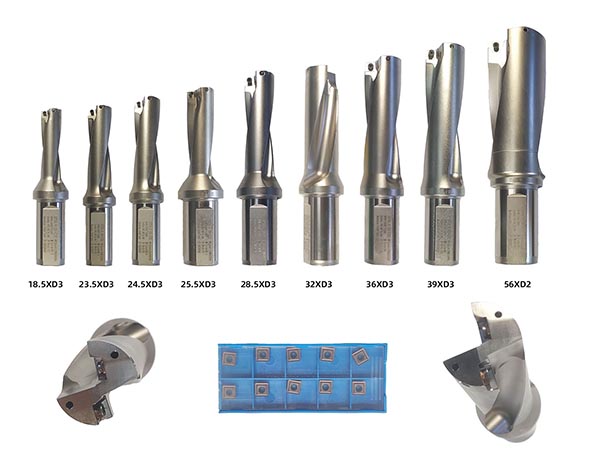Indexable Inserts vs. Solid Drills: Which is the Smarter Investment?
In the realm of precision machining within modern manufacturing, tool selection is a critical factor that directly impacts both productivity and cost control. Among the two mainstream solutions for metal cutting—indexable inserts and solid drills—the performance differences often lie beneath a complex web of material characteristics, operating conditions, and hidden cost structures. Drawing on empirical data from various industry applications, this article systematically analyzes the performance differences of these two tool types in processing common materials like cast iron and stainless steel. From microstructural failure mechanisms to macro-level cost models, it reveals often-overlooked parameters and risk factors in tool selection, offering production managers a logical framework for informed decision-making.
Fundamental Performance Comparison
1. Initial Procurement Cost
- Indexable Inserts: Lower per-unit price (approximately 1/5 of solid drills), but require matching toolholders.
- Solid Drills: Higher unit cost, but no additional components required.
- Case Study: A Vietnamese customer saved $8,000 in upfront investment by switching to insert-based tooling on 10 machines for cast iron machining.
2. Tool Life
- Indexable Inserts: Shorter per-edge lifespan (~45 minutes), but each insert can be indexed 4–8 times.
- Solid Drills: Used continuously until end-of-life (~6–8 hours), with no indexing losses.
| Parameter | Indexable Insert System | Solid Carbide Drill |
|---|
| Daily Machine Runtime | 16 hours | 16 hours |
| Average Tool Life | 2 hours per edge | 7 hours |
| Number of Machines | 20 | 20 |
| Workdays per Month | 26 | 26 |
| Theoretical Monthly Consumption | (16×20×26) / 2 ÷ 8 edges = 3,328 inserts | (16×20×26) / 7 ≈ 1,189 drills |
Underlying Differences in Materials Science
1. Microstructural Resistance to Failure
- Indexable Inserts
- Coating Delamination Threshold:
- CVD coatings under sustained 600°C conditions vs. PVD coatings under chipping resistance tests.
- Solid Drills
- Grain Boundary Reinforcement Technology:
- Fatigue life comparison between ultrafine-grain carbide (0.3μm) and standard-grade materials (0.8μm).
2. Failure Warning Signatures
| Failure Type | Early Signs in Inserts | Warning Signals in Solid Drills |
|---|
| Chipping | Cutting noise increases by 3dB | Chip discoloration |
| Wear | 50% more burrs on the workpiece | Axial force fluctuations exceed 15% |
| Thermal Deformation | Tip bluing | Hole diameter shrinkage by 0.01mm |
Operational Differences
| Factor | Indexable Inserts | Solid Drills |
|---|
| Tool Change Frequency | Every 45–90 minutes | Every 6–8 hours |
| Operator Skill Requirement | Requires precise positioning | Easy to clamp and go |
| Maintenance | Regular groove cleaning | Requires professional regrinding equipment |
Note: An Indonesian customer reported a 37% drop in downtime with solid drills due to limited operator skills.
Machining Performance in Practice
1. Cast Iron Machining Comparison
- Inserts: Surface roughness Ra 3.2 – ideal for roughing.
- Solid Drills: Surface roughness up to Ra 1.6 – preferred for finishing.
2. Stainless Steel Machining Challenges
- Inserts: Prone to chip entanglement (solution: custom chipbreaker geometry).
- Solid Drills: Susceptible to built-up edge (solution: nano-coating technology).
Long-Term Cost Accounting
- Annual Cost Formula:
- (Tool Purchase Cost + Tool Change Labor + Scrap Losses) × Quantity Used
- Cost Calculator: A web-based interactive tool allows users to input equipment quantity to auto-generate comparison reports.
- Typical Scenarios:
- Small-Batch, High-Mix Production: Inserts offer better economics (Turkish client saved 19%).
- High-Volume, Single-Material Production: Solid drills ensure better stability (Mexican client reported a 12% increase in yield).
Decision-Making Flowchart
- Start with Material Hardness:
- 45 HRC → Prioritize solid drills
- <45 HRC → Consider indexable insert systems
- Next, Assess Order Type:
- Short-term/temporary orders → Inserts for faster turnaround
- Long-term/repeat orders → Solid drills for process optimization
- Finally, Evaluate Workforce Skill Level:
- Low experience → Choose solid drills
- Skilled team → Use inserts to lower cost
Industry-Specific Decision Matrix
1. Automotive Manufacturing
- Cylinder Block Machining Pain Points:
- Aluminum-cast iron hybrid machining requires insert systems to:
- Handle sudden cutting speed transitions (800 → 1200 rpm)
- Maintain dry/wet cutting stability
- (Case Reference: Tesla supplier’s process parameters)
- Solid Drill Advantages:
- Self-centering tip design (reduces runout by 50%)
- Deep hole chip evacuation performance (12xD benchmarking tests)
2. Aerospace
- Titanium Alloy Machining Economic Model:
- Insert Cost Equation:
- (Effective Cutting Time / Insert Price) × Workpiece Value Factor
- Solid Drill System Benefits:
- Thin-walled part processing case (35% reduction in fixture costs at one aerospace firm)
- Stable curved surface machining (lower surface roughness standard deviation)
Conclusion
The ultimate value of a cutting tool lies in its precision fit with the machining scenario. Comparative analysis reveals that indexable inserts excel in rapid changeovers and small-batch production due to cost efficiency, while solid drills offer superior consistency for high-volume operations. Decision-makers must account for variables such as material hardness variation, equipment automation level, and operator expertise. Building a multidimensional assessment system that includes energy monitoring and quality risk is essential. In the future, as hybrid machining technologies evolve, the combined use of both tools may redefine conventional workflows. However, the core remains a continuous pursuit of balancing physical machining limits with economic outcomes.


 We like to do design according to all the customers' requirements, or offer them our new designs. With strong OEM/ODM capabilities, we can fill your sourcing demands.
We like to do design according to all the customers' requirements, or offer them our new designs. With strong OEM/ODM capabilities, we can fill your sourcing demands.